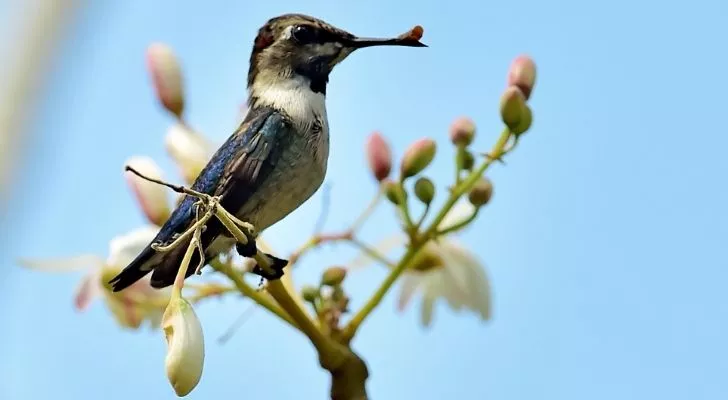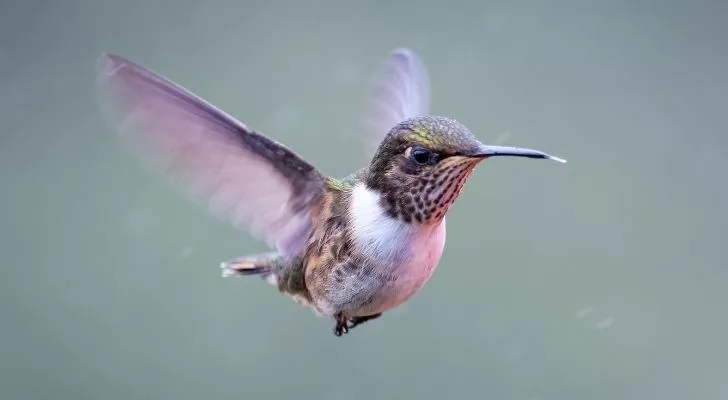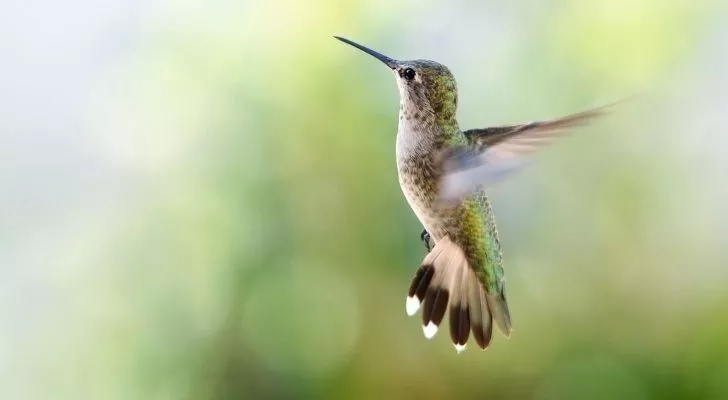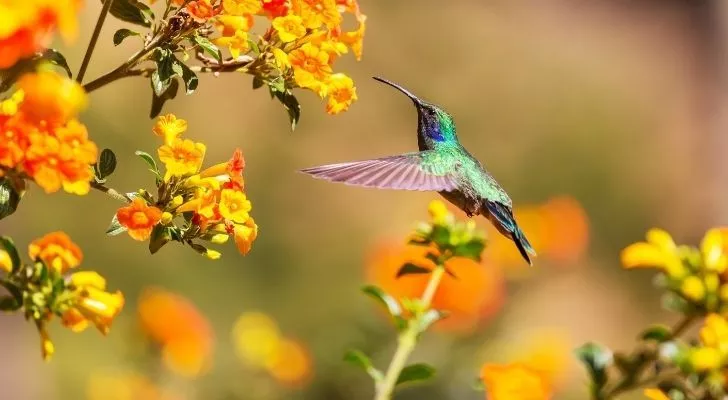It is a known fact that hummingbirds are the only birds capable of flying backward.
The biological family Trochilidae consists of 338 species of hummingbirds, all of which have unique characteristics.
Hummingbirds are mostly found in tropical regions of Central and South America, with a few species occasionally migrating to Alaska.
Hummingbirds are admired for their agility and beauty, making them a fascinating bird species.
- The Bee Hummingbird is the smallest bird in the world.
- Hummingbirds need to eat up to eight times an hour.
- Most hummingbirds prefer warmer climates.
- Hummingbirds are the only birds capable of flying backward.
- Hummingbirds are known for their aggressive behavior!
- Hummingbirds were highly valued by the Aztecs.
- FAQ
The Bee Hummingbird is the smallest bird in the world.

Most species of hummingbirds measure between 3 to 5 inches (7.5-13 cm) long.
The Bee Hummingbird, found in Cuba, is only 2 inches (5 cm) long and weighs less than 0.07 ounces (2 g).
It is believed that the Bee Hummingbird evolved to feed on smaller flowers, giving it an advantage over larger hummingbird species.
Hummingbirds need to eat up to eight times an hour.

Hummingbirds have a diet consisting of nectar and small insects, as nectar alone lacks other essential nutrients.
They feed on insects while flying and need a constant source of food to balance out the energy used during flight.
Most hummingbirds prefer warmer climates.

Many hummingbird species are migratory birds, traveling to the tropics during winter.
However, some species, such as the Rufous hummingbird, can be found during winter in North America.
The Rufous hummingbird can migrate up to 3000 miles (4828 km) from Alaska to Mexico.
Hummingbirds are the only birds capable of flying backward.

Hummingbirds are named after the sound they make when flapping their wings rapidly.
The flight of hummingbirds has been studied for a long time due to their unique abilities. With the help of modern technology, we now have a better understanding of their flying techniques and differences. The use of high-speed cameras and wind tunnels has enabled us to capture larger hummingbirds beating their wings at a rate of 12 beats per second and smaller ones at more than 80 times per second. These birds can reach top speeds of 34 miles per hour and can even fly backward. Hummingbirds are also incredibly tiny, with nests half the size of a walnut, made of delicate materials such as moss and spider silk. Despite their agility, they have many natural predators ranging from reptiles to insects, with some species of praying mantis able to catch them mid-air. They lay eggs that can weigh up to 10% of their mother’s body weight, even though they are the smallest bird eggs in the world, measuring less than 0.5 inches in length. Hummingbirds have speedy metabolisms and must eat frequently to survive. To survive the night, they enter a deep-sleep state known as torpor, where their heart rate and core temperature slow down significantly.
Despite being able to survive the night, hummingbirds can lose up to 10% of their body weight during the process!
Hummingbirds are known for their aggressive behavior!

Hummingbirds may not appear to be threatening due to their small size, but they are one of the most aggressive bird species.
They are known to fiercely defend their territory, even against larger birds like crows, jays, and hawks.
Hummingbirds were highly valued by the Aztecs.

The Aztecs associated hummingbirds with their god of sun and war and often wore talismans made from hummingbird bones or materials resembling the bird for increased energy and advantage in warfare.
Hummingbirds have been a cultural icon for thousands of years, with their ability to hover while drinking nectar and their small yet fierce nature making them a magical and mesmerizing creature.
FAQ
1. What is a hummingbird?
A hummingbird is a small, colorful bird that is known for its ability to hover in mid-air by rapidly flapping its wings. There are over 300 species of hummingbirds, and they are native to North and South America.
2. What do hummingbirds eat?
Hummingbirds primarily feed on nectar from flowers, but they also eat insects and spiders to supplement their diet. In captivity, they can be fed a mixture of sugar water and vitamins.
3. How fast do hummingbirds fly?
Hummingbirds can fly at speeds of up to 60 miles per hour, making them one of the fastest birds in the world. They can also hover in mid-air and fly backwards.
4. How long do hummingbirds live?
Hummingbirds have a relatively short lifespan, with most living only 3-5 years. However, some species have been known to live up to 10 years in captivity.
5. How do hummingbirds mate?
During mating season, male hummingbirds will perform elaborate aerial displays to attract a mate. Once a female is interested, the male will perform a series of dives and swoops before mating.
6. What is the smallest hummingbird?
The bee hummingbird, which is native to Cuba, is the smallest hummingbird in the world. It measures only 2.25 inches long and weighs less than a penny.
7. What is the largest hummingbird?
The giant hummingbird, which is native to the Andes mountains in South America, is the largest hummingbird in the world. It measures up to 9 inches long and weighs up to 22 grams.
8. How do hummingbirds migrate?
Hummingbirds are able to migrate long distances, with some species traveling up to 2,000 miles each way. They rely on nectar from flowers to fuel their journey, and they are able to store enough energy to travel for days without eating.

Zayn Anderson is a prolific writer with a passion for uncovering the world’s intriguing facts. Armed with an insatiable curiosity, he delves into various subjects, from history and science to nature and technology.
